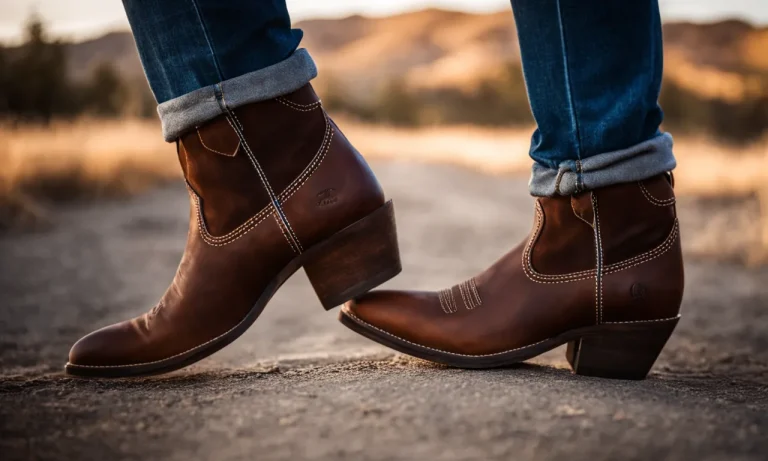Having a loose or detached shoe heel can be annoying and even dangerous if it causes you to trip. Fortunately, repairing a loose heel is a relatively easy DIY fix. With some basic supplies, you can reattach a loose heel or replace worn heel taps in no time.
If you’re short on time, here’s a quick answer to your question: Remove any detached pieces and rough up the area with sandpaper. Apply shoe glue or rubber cement to both surfaces and press together firmly for 30 seconds. Allow several hours to fully cure before wearing.
In this comprehensive guide, we will cover everything you need to know to successfully repair the heel of a shoe yourself. We’ll discuss the common causes of heel problems, what supplies you need, how to fully detach a loose heel, and step-by-step instructions for reattaching it or replacing heel taps.
With the right technique, you can easily fix heel issues and save yourself an expensive trip to the cobbler.
What Causes Loose and Detached Shoe Heels
Loose and detached shoe heels can be a frustrating issue that many people encounter. Understanding the causes of this problem can help you prevent it from happening and extend the lifespan of your favorite shoes. Here are some common reasons why shoe heels become loose or detached:
Normal wear and tear
One of the most common causes of loose or detached shoe heels is normal wear and tear. Over time, the constant pressure and friction exerted on the heels can weaken the adhesive or stitching that holds them in place.
This is especially true for high-heeled shoes, as the force exerted on the heel is often greater.
Improper installation
Another reason for loose or detached shoe heels is improper installation. During the manufacturing process, if the heels are not securely attached to the shoe, they may become loose over time. This can happen if the nails or screws used to secure the heel are not properly aligned or tightened.
Weak glue or nails
Weak glue or nails can also contribute to loose or detached shoe heels. If the adhesive used to attach the heel to the shoe is of poor quality or not applied properly, it may not provide a strong enough bond.
Similarly, if the nails or screws used to secure the heel are weak or improperly inserted, they may not hold the heel in place firmly.
It is worth noting that some shoe brands may be more prone to loose or detached heels due to inferior manufacturing processes or materials. Therefore, it is important to research and invest in shoes from reputable brands known for their quality craftsmanship.
Supplies Needed for DIY Shoe Heel Repair
Rubber cement or E6000 glue
One of the most important supplies you’ll need for repairing the heel of your shoe is a strong adhesive. Rubber cement or E6000 glue are two popular options. These adhesives are designed to bond well with rubber and other shoe materials, providing a secure and long-lasting repair.
You can find these glues at most craft or hardware stores.
Replacement heel taps
If the heel tap on your shoe is worn out or damaged, you’ll need to replace it. Heel taps are small rubber or plastic pieces that attach to the bottom of the heel, providing traction and preventing excessive wear. You can purchase replacement heel taps online or at shoe repair shops.
Make sure to choose the correct size and shape for your shoe’s heel.
Sandpaper
Sandpaper is essential for preparing the surface of the shoe’s heel before applying adhesive. It helps remove any rough or uneven areas, ensuring a smooth and clean surface for the glue to adhere to. Look for sandpaper with a medium grit for this task.
Small hammer
A small hammer will come in handy when removing the old heel tap or tapping in a new one. It allows you to apply controlled force to ensure a secure fit. Be sure to use a small hammer to avoid damaging the shoe or the heel tap.
Scrap wood block
A scrap wood block is useful when hammering in the new heel tap. Place the block behind the heel to provide support and prevent any damage to the shoe’s sole or heel. It also helps distribute the force evenly, ensuring a secure attachment.
Rags
Rags or old cloths are necessary for cleaning and wiping away any excess glue or dirt during the repair process. They help keep your work area clean and prevent any unwanted messes.
Newspaper
Before you start the repair, it’s a good idea to lay down some newspaper to protect your work surface. This will catch any glue drips or debris and make cleanup easier. Plus, it’s always nice to have a designated space to work on without worrying about making a mess.
How to Fully Remove a Loose Heel
When you notice a loose heel on your shoe, it’s important to take action before it becomes a bigger problem. Here are a few methods you can try to fully remove a loose heel:
1. Try wiggling it loose
If your heel is only slightly loose, you may be able to wiggle it free with a bit of effort. Hold onto the shoe securely and gently twist and turn the heel in different directions. This motion can help loosen the adhesive or screws holding the heel in place.
Be careful not to apply too much force as it could damage the shoe.
2. Use a heel separator tool
If wiggling the heel doesn’t work, you can try using a heel separator tool. These tools are specifically designed to help remove heels by creating space between the shoe and the heel. Insert the separator tool into the gap between the heel and the shoe, and gently apply pressure to pry the heel loose.
This method is particularly effective for heels that are firmly attached.
3. Carefully pry it off
If the above methods don’t work, you may need to resort to carefully prying the heel off. Use a small flathead screwdriver or a butter knife to create leverage between the shoe and the heel. Be extremely cautious to avoid damaging the shoe or injuring yourself.
Apply gentle pressure and gradually work your way around the heel until it comes off.
Remember, it’s always a good idea to consult a professional shoe repair expert if you’re unsure about removing the heel yourself. They have the knowledge and experience to handle the repair safely and efficiently.
Additionally, if your shoe is still under warranty, attempting to remove the heel yourself may void the warranty.
For more detailed instructions and visuals on how to remove a loose heel, you can visit www.shoerepairpro.com. Their comprehensive guide provides step-by-step instructions along with helpful tips to ensure a successful heel removal.
Steps to Reattach a Detached Heel
Roughen and clean the area
If your shoe’s heel has come loose and needs repair, the first step is to roughen and clean the area where the heel attaches to the sole. This will help create a better surface for the adhesive to bond to.
Use sandpaper or a file to roughen the surface, then wipe away any debris or dirt using a damp cloth.
Apply adhesive to both surfaces
Once the area is clean, it’s time to apply adhesive to both the heel and the sole. Choose a strong adhesive that is suitable for shoe repairs. Apply a thin, even layer of adhesive to both surfaces, making sure to cover the entire area where they will be joined.
Follow the manufacturer’s instructions for the specific adhesive you are using.
Press together firmly for 30 seconds
After applying the adhesive, press the heel and sole together firmly for at least 30 seconds. This will help ensure a strong bond between the two surfaces. Apply steady pressure and make sure the heel is aligned properly before pressing them together.
Use clamps or rubber bands if necessary to hold the heel in place while the adhesive sets.
Allow several hours to cure before wearing
Once the heel is securely attached, it’s important to allow the adhesive to cure properly before wearing the shoes. Check the manufacturer’s instructions for the recommended curing time, but typically it takes several hours for the adhesive to fully set.
Avoid putting pressure on the repaired area during this time to prevent any damage to the bond.
Repairing the heel of your shoe can save you money and extend the life of your favorite footwear. By following these steps and using the right adhesive, you can reattach a detached heel successfully. However, if you are unsure or uncomfortable with the repair process, it’s always a good idea to seek professional help from a shoe repair shop.
How to Replace Worn Heel Taps
Remove old heel tap
When your shoe’s heel tap starts to wear down, it’s important to replace it to maintain the stability and longevity of your shoes. To begin, you’ll need a pair of pliers to carefully remove the old heel tap.
Gently grip the tap and wiggle it back and forth until it loosens and can be easily pulled out. Be sure to discard the old tap, as it is no longer usable.
Sand down and clean heel area
Once the old heel tap has been removed, it’s time to prepare the heel area for the new tap. Use sandpaper to gently sand down any rough or uneven surfaces on the heel. This will ensure a smooth and secure attachment for the new tap.
After sanding, use a clean cloth or brush to remove any dust or debris from the heel area.
Apply glue and attach new heel tap
Next, apply a small amount of shoe glue to the bottom of the new heel tap. Make sure to use a glue specifically designed for shoe repairs. Press the tap firmly onto the heel, aligning it with the original position. Apply some pressure to ensure a strong bond between the tap and the heel.
Allow the glue to dry for the recommended time specified on the product packaging.
Allow time to fully cure
After attaching the new heel tap, it’s important to give it enough time to fully cure. This will ensure that the tap is securely attached and will not come loose easily. Follow the manufacturer’s instructions for the recommended curing time.
It’s best to avoid wearing the shoes until the glue has completely dried and cured.
By following these steps, you can easily replace worn heel taps and extend the life of your favorite pair of shoes. Remember to take your time and be gentle during the process to avoid damaging the shoe. With a little effort, your shoes will be back to looking and feeling great!
Conclusion
With the right supplies and techniques, you can easily repair heel problems at home for a fraction of the cost of professional repair. Just be sure to fully detach any loose pieces, roughen and clean the area, apply adequate adhesive, and firmly press the surfaces together.
Allowing the full curing time before wearing is also critical for a long-lasting fix. Follow these steps and your shoes will have brand new staying power.






